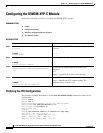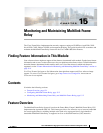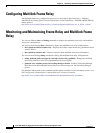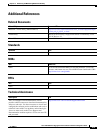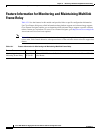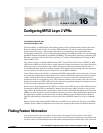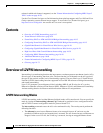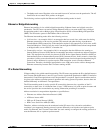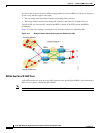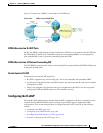
CHAPTER
16-1
Cisco ASR 1000 Series Aggregation Services Routers Software Configuration Guide
OL-16506-17
16
Configuring MPLS Layer 2 VPNs
First Published: March 29, 2012
Lasted Revised: May 25, 2015
The Frame Relay to ATM Bridged Interworking feature provides interoperability between the Frame
Relay attachment virtual circuit (VC) and the ATM attachment VC that are connected to different
provider edge (PE) routers. The bridged encapsulation corresponding to the bridged (Ethernet)
interworking mechanism is used to enable this interoperability. The Ethernet frames are carried through
the MPLS network using Ethernet over MPLS (EoMPLS). The interworking function is performed in the
PE routers connected to the Frame Relay attachment VC and the ATM attachment VC based on RFC
2684 and RFC 2427.
The xconnect support on Gigabit EtherChannel (GEC) Virtual Private Wire Service (VPWS) on ASR
1000 feature enables service providers to supply connectivity between customer sites with existing data
link layer (Layer 2) networks by using a single, integrated, packet-based network infrastructure—a
Cisco MPLS network. Instead of separate networks with separate network management environments,
service providers can deliver Layer 2 connections over an MPLS backbone.
Layer 2 Gateway Protocol (L2GP) is a recommended IEEE standard (802.1ah) to address the issues that
arise when two independent, bridged domains are connected redundantly through an arbitrary number
of links. L2GP defines how the forwarding gateways are selected, so that only redundant ports are
blocked and there are no temporary loops. The transition should be at least at the same speed in which
Spanning Tree Protocol (STP) L2GP resolves the transient loop problem during reconvergence because
it does not require cooperation from the outside domain.
Reverse Layer 2 Gateway Protocol (R-L2GP) is a variation of an L2GP. In case of an R-L2GP, the pseudo
information of the R-L2GP is transmitted by network provider edges (nPEs) instead of user provider
edges (uPEs). R-L2GP provides a mechanism to send out static preconfigured bridge protocol data units
(BPDUs) on each ring access port of the nPEs to stimulate a per-access ring instantiation of the protocol.
R-L2GP enables the PEs to avoid the burden of running Multiple Instances Spanning Tree Protocol
(MISTP) when multiple independent access networks that run MISTP connect to a pair of redundant
PEs.
High-Level Data Link Control (HDLC) Ethernet over MPLS is part of the Any Transport over MPLS
(AToM) solution. HDLC and Ethernet are two link-layer transports that utilize the AToM architecture.
Finding Feature Information
Your software release may not support all the features documented in this module. For the latest
information about features and caveats, see the release notes document pertaining to your platform and
software release. To find information about the features documented in this module and to view a list of the




